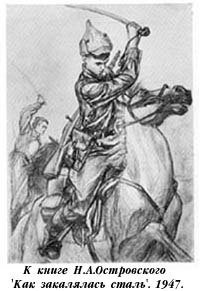 |
Since the 1930s and 1940s Pakhomov illustrated books of N. A. Ostrovsky, I.S. Turgenev, N. A. Nekrasov, or Lenin tales in children's magazines Siskin and Hedgehog. The style of his work changed: the local patch and silhouette replaced with bright and dynamic line, and fine stroking. His "graphic painting" was replaced with "painting graphics".
To attain a new goal in book design, Pakhomov chose the life-sketching technique, with rare use of color. He strove for personalization, drawing the viewer's attention to the facial expression and gestures of his characters. With
linear drawing, the artist created images that appeared as charged with emotion and spontaneity but were devoid of psychological content. His illustrations for
books of Maykovsky and Marshak in the late 1930s and early 1940s lack the previous clear perception of the environment and innovatory characters. Children in Pakhomov's works think and feel identically, despite the precise portraiture. |
